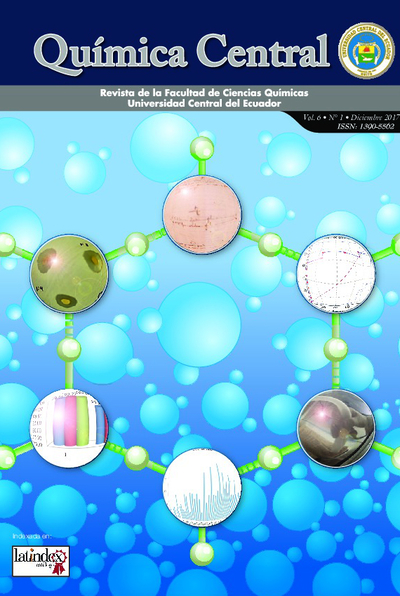Formulación de una solución antifúngica para la Preservación del Archivo Histórico de la Universidad Central del Ecuador
DOI:
https://doi.org/10.29166/quimica.v6i1.1410Keywords:
Documentary conservation, Fluconazole, Antifungal solution, NebulizationAbstract
The documentary conservation in recent years plays an important role in society, because it tries to recover the
historical memory, and the documentary acquis of it. One of the most prevalent and difficult problems is the
existence of fungi and its metabolic products in documents, as it potentially causes a total loss of information,
hindering the restoring process as well. The study seeks to formulate a solution to treat this fungal contamination,
using Fluconazole as an antifungal. We started by isolating fungi found in the books, followed by the use
of the pseudo-ternary diagram for the formulation of the solution of Fluconazole, and finally the effectiveness
of this formulations was evaluated by using modified microbiological techniques, obtaining a percentage
reduction on CFU of 90%, by nebulization a solution of Fluconazole at 24% and co-solvents: Water: 20%,
Methanol: 50%, Ethanol: 30%, during 15 minutes.
Downloads
References
SanMartín,N. (2015).Proyecto de Recuperación de la Memoria Historica y Conservación del Acervo, Quito: UCE.
Aristegui, B. (2002). El reino de los hongos. Revista Iberoamericana de Micología, 2,3.
Biasoli, M. (05 de 2013). Estructura y actividad de antifungicos. Recuperado el 20 de 07 de 2015, de http://www.fbioyf.unr.edu.ar/evirtual/pluginfile.php/4130/course/section/1519/Estructura%20y%20actividad%20de%20los%20antifungicos.pdf
Selvaduray, G. (2004). Ternary phase diagrams.California.
Farmacopea; Brazileña. (2010). Agencia Nacional de Vigilancia Sanitaria.Obtenido de http://www.anvisa.gov.br/hotsite/cd_farmacopeia/index.htm.
Teran, R. (2015). Manual de Laboratorio de Micorbiologia Farmaceutica.Quito.
Marcowist, B. (1990). How to prevent and remove mildew. Washington: Government Printing.
Tangafire, V. (2011). UDEA. Obtenido de: http://aprendeenlinea.udea.edu.co/lms/moodle/mod/resource/view.php?inpopup=true&id=100812
Avendaño, C. (2001). Introducción a la química farmacéutica (2a. ed.). Madrid, España: McGraw-Hill.
USP32-NF27. (2009). The United States Pharmacopeial The National Formulary. (32a. ed.).
Downloads
Published
How to Cite
Issue
Section
License
Los originales publicados en las ediciones impresa y electrónica de esta revista QUÍMICA CENTRAL son propiedad de la Universidad Central del Ecuador, siendo necesario citar la procedencia en cualquier reproducción parcial o total.
La propiedad intelectual de los artículos publicados en revista QUÍMICA CENTRAL pertenece al/la/los/las autor/a/es/as, y los derechos de explotación y difusión científica están direccionados para la revista QUÍMICA CENTRAL mediante CARTA DE AUTORIZACIÓN DE PUBLICACIÓN publicada en esta plataforma.


